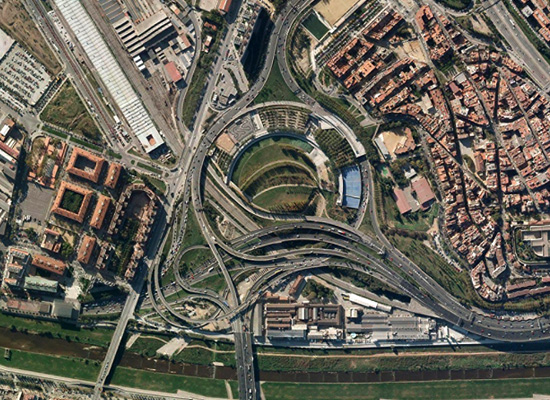
This is a quick survey of sorts in three parts. This is the second part.
Covering about 7.5 acres under Interstate 5 in Seattle, Washington, is the I-5 Colonnade Park. Weaving through this concrete forest are trails, pedestrian crossings connecting two neighborhoods, an off-leash dog park and a couple of picnic areas. A major portion of the park is a series of mountain bike skills trails constructed by the Evergreen Mountain Bike Alliance and its volunteers.
This park, together with Burnside Skatepark, pictured above, is an instructive contrast to the super-designery landscapes in the first part of this quickie survey. It suggests a way to rehabilitate these forgotten, dark urban spaces without eradicating heterogeneity and fostering exclusion, which often accompany so many regeneration projects. This park is “dirty,” not Dutch, but thrives nonetheless.
A short documentary about the mountain bike park can be viewed here.






Raumlabor's Spacesbuter is a mobile pavilion made of “an inflatable bubble-like dome that emerges from its self-contained compressor housing. The dome expands and organically adjusts to its surroundings, be it in a field, a wooded park, or below a highway overpass. The material is a sturdy, specially-designed translucent plastic, allowing the varying events taking place inside of the shelter — dance parties, lecture series, or dinner buffets — to be entirely visible from the outside and likewise the exterior environments become the events’ backdrops.
“When inflated, the dome has proportions of 65.5 feet deep, 33 feet wide and 21 feet high. The space is highly adaptable and will morph depending on the surrounding environment. It merges with its surroundings: enveloping lampposts and trees while yielding to building facades or nearby vehicles.”




Looking like a den for muggers awaiting lost pedestrians retracing one desire line after another in the hopes of finding an escape route is West 8's Carrascoplein. Located underneath railway tracks on the outskirts of Amsterdam, the park (perhaps landscaped boulevard is a more apt term), as described by Ian Bourdain, is “made up what initially appears to be little more than an artificial wooded landscape: grass and asphalt surfaces littered with cast-iron tree stumps lit up from within. At night, the latter glow and cast shadows over the concrete columns and undersides of the overhead bridges. The effect is at once calm and unsettling, at times empty and eminently ignorable (especially during the day), and at others (particularly after nightfall), ambient, moody and almost unsettling in the way that light, shadows and colour flicker across the site.”
The park may look inhospitable and barren in photographs, but Bourdain assures us that the park “has been welcomed by local pedestrians, many of whom now feel much more willing to traverse the space, as well as by those seeking an alternative urban experience – in this case, a dance of light and shadows. The risk of doing something quite strange in an out-of-the-way location has been repaid by improvements in the quality of the place and its attractiveness to people living elsewhere in Amsterdam.”


Battle i Roig's Parc Nus de la Trinitat (1993) is located in one of the most important road networks in Barcelona. With public open spaces at a premium, the designers planned out a very dense program arranged within two semicircular bands around a central circular green space. Squeezed inside include a water channel, two tennis courts, urban farm gardens, a volleyball court, a basketball court, a mini-football pitch and picnic areas. The layout no doubt echos the presence of the ring roads; nevertheless, through grade changes, landform construction and strategic plantings, the roundabout and its traffic are visually and aurally screened out. In some areas, you would hardly think that you were in the middle of “the largest system of ring roads in the city.”
(Or actually, according to this post [in Catalan; thanks, Louis Carrogis, for the translation] and the photos contained within, the park is hardly a peaceful respite. In fact, it's in a very dilapidated state. The entrance to the park, says the author, looks like an industrial zone or a big parking lot that's far from inviting. The pool is without water, and the bathrooms and courts badly need maintenance. The landscape is unsightly. Must be the recession, drought — i.e., climate change — and opportunistic squatters marginalized from other public spaces.)



To be continued.